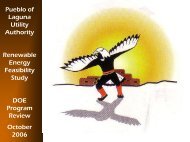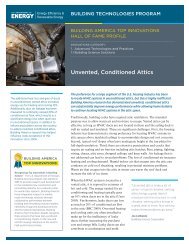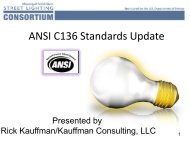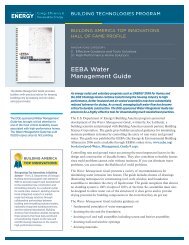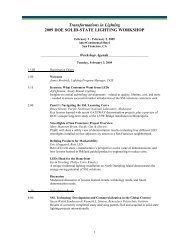Create successful ePaper yourself
Turn your PDF publications into a flip-book with our unique Google optimized e-Paper software.
Postings: from the<br />
desk of Jim <strong>Brodrick</strong><br />
You may recall that not too long ago, there was some mention in<br />
the news media about possible negative health effects of<br />
exposure to street lighting. While not all of the stories were<br />
completely accurate, we thought we should investigate further,<br />
so that's what DOE did.<br />
At our fifth annual SSL Market Introduction Workshop, which<br />
was held in Philadelphia in July, we assembled a panel of<br />
experts on the subject to give us an update on what we know –<br />
and don't know – about the health effects of exposure to light at<br />
night, focusing on the differences in spectra between available<br />
light source technologies. A white paper summarizing the<br />
findings of that panel is now available online, and is entitled<br />
"Light at Night: The Latest Science."<br />
The panel was composed of several respected experts in the<br />
field: Ronald Gibbons of Virginia Tech Transportation Institute,<br />
George Brainard of the Neurology Department at Jefferson<br />
Medical College, and Mariana Figueiro of the Lighting Research<br />
Center at Rensselaer Polytechnic Institute. What did they<br />
conclude? First and foremost, that more research is needed.<br />
Based on the scientific studies that have been done to date, it's<br />
unclear what changes, if any, should be made to current best-<br />
practice lighting design. For example, we now know that the light<br />
detected by our eyes doesn't just enable us to see, it also helps<br />
to set our biological clock – or "circadian rhythm," in scientific<br />
parlance. It does this through specialized cells called<br />
"intrinsically photosensitive retinal ganglion cells," which were
discovered just a few years ago and – mercifully – are known as<br />
ipRGCs for short. These ipRGCs are not involved in the visual<br />
process, but affect the body's production of the hormone<br />
melatonin, which plays a key role in regulating circadian rhythm.<br />
There's evidence that disrupting the circadian rhythm can cause<br />
health problems, and that short-wavelength (blue) light has a<br />
greater effect on melatonin production than light in other parts of<br />
the spectrum.<br />
At this point in time we don't know enough to determine how<br />
much nighttime light exposure it takes to affect health adversely.<br />
In fact, it appears that daytime light exposure – especially to<br />
light in the blue range – is something many of us could actually<br />
use more of to function at optimal efficiency, and may very well<br />
prove to be more significant in setting our biological clocks than<br />
exposure to light at night. One panelist recommended daytime<br />
light exposures be increased and enriched with short-<br />
wavelength (blue) visible radiation, while nighttime exposures be<br />
reduced and have less of a short-wavelength component.<br />
But there's also the matter of the effect of spectrum on visual<br />
performance. As another panelist reported, there's evidence that<br />
broad-spectrum light sources (i.e., those featuring a substantial<br />
blue element) improve visibility over warmer-colored light<br />
sources in outdoor environments at night, even when those<br />
broad-spectrum light sources emit less photopic (i.e., "bright")<br />
light. So phosphor-conversion LEDs, which currently operate<br />
most efficiently when producing cooler (bluer) light, have the<br />
potential to save a lot of energy while improving nighttime<br />
visibility and safety.<br />
There's no question that lighting design criteria should be<br />
sensitive to our biological needs as well as to our visual needs.<br />
But as you can see, right now the issue of street lighting's effect<br />
on health is far from clear-cut, with many ramifications and<br />
nuances and a definite need for further research.
Just as we posted the white paper from the July workshop<br />
panel, along came a new report from a French agency, citing<br />
potential damage to the eyes from LEDs and other broad-<br />
spectrum light sources of high luminance. Some of you may<br />
have seen it or heard about it. It seems to be a review of the<br />
existing scientific literature on the topic. We'll give it a careful<br />
look, just as we've been doing with the street lighting issue, to<br />
determine whether it warrants any change in the course that<br />
solid-state lighting has been on. If SSL is to achieve its potential,<br />
we can't afford to have any preconceived notions – but neither<br />
can we afford to rush to judgment. Technology is driven by<br />
science, and science is based on facts and consensus<br />
interpretation, which take time and a lot of hard work.<br />
As always, if you have questions or comments, you can reach me at<br />
<strong>posting</strong>s@lightingfacts.com.




